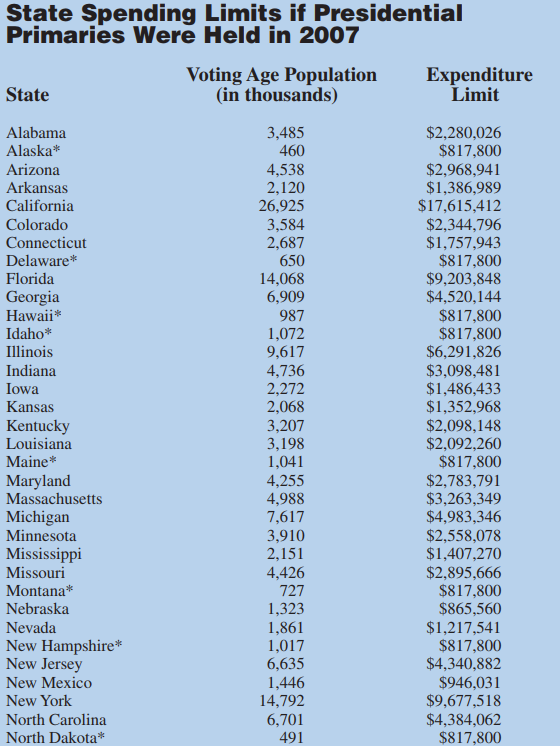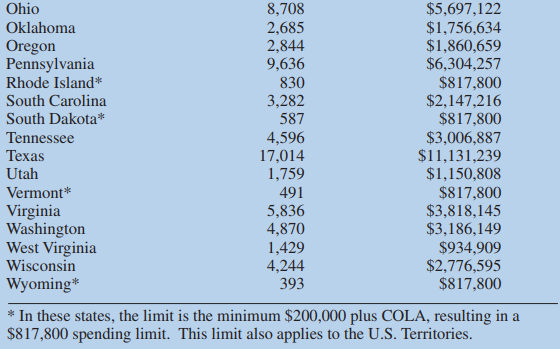Estimated presidential spending limitations (2007)
Under the Presidential Election Campaign Fund Act (the Fund Act) and the Presidential Primary Matching Payment Account Act (the Matching Act), presidential candidates who accept public funding agree, among other things, to abide by overall spending limits as well as by state-by-state spending limits.(1) These limits are calculated using the cost of living adjustment (COLA) since 1974 and the voting age populations (VAPs) of each state for the year in which the election is held. However, in order to help presidential campaigns estimate the limits for the upcoming elections, the Commission releases spending limit figures for the year preceding the presidential election year.
If the presidential election were held in 2007, the Commission calculates that each primary contender would be able to spend roughly $55 million seeking his or her party's nomination. Party nominees would be able to spend nearly $82 million in the general election. These figures merely provide an estimate of what the actual spending limits will be. Official spending limits for the 2008 presidential elections, which must be updated for changes in state VAPs and the COLA, will not be available until early 2008.
The overall "base" spending limit for presidential primary campaigns is $10 million, adjusted for the cost of living. For 2007, the inflation adjusted overall spending limit is $40,890,000. The additional state-by-state limits are keyed to the VAP of each state, with a minimum of at least $200,000, plus a COLA for those states with a low VAP. The formula for setting state limits is 16¢ multiplied by the VAP + COLA. A less populated state, such as New Hampshire, would have a limit of $200,000, plus COLA, or $817,800. A larger state, such as California, would have a limit of [16¢ x 26,925,000 (VAP), plus COLA,] or $17,615,412.
Commission regulations exempt certain expenses from the overall spending limits. For example, an exemption for 20 percent of a campaign's fundraising expenses effectively raises the total amount primary contenders may spend in the pre-convention period to $49,068,000. Campaigns may also spend up to an additional 15 percent of the overall spending limit on legal and accounting expenses. Thus, the maximum amount that a primary committee could spend—taking both of these exemptions into account—is $55,201,500.
While these exemptions are derived from the overall spending limit, they also affect state spending limits. The Commission provides guidance on how campaigns must allocate expenses to particular state primaries. A campaign may consider 50 percent of all expenses that are allocable to a given state to be "exempt fundraising" and need not count these expenses toward the spending limit for that state.(2) Thus, a campaign may use its available fundraising exemption selectively to assure that the 20 percent overall exemption is not exhausted before particular primaries where the state spending limitation is of greatest concern. A campaign availing itself of the maximum fundraising exemption in New Hampshire, for example, might permissibly spend as much as $1.64 million on the New Hampshire primary, even though the calculated spending limit is $817,800.
In the general election, major party nominees who choose to accept public funding will receive at least $81.78 million each to finance their campaigns ($20 million, plus COLA over 1974). The nominees must spend only those funds and not supplement the public funds with any private contributions for the campaign. The nominees may, however, raise private funds to cover certain legal and accounting costs, which are not subject to the spending limit. Additionally, the two major parties will be able to spend at least $18,773,200 million on their respective presidential nominees in coordinated expenditures.
1) These limits apply only to those campaigns choosing to accept federal matching funds. Campaigns that opt to forego federal funding may spend unlimited amounts of money.
2) Direct mail expenses for mailings occurring more than 28 days before the primary election may be considered 100 percent exempt fundraising. Direct mailings sent within 28 days before the election may only be considered 50 percent exempt fundraising.

